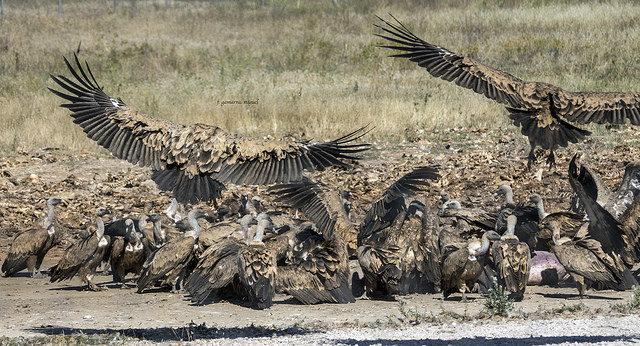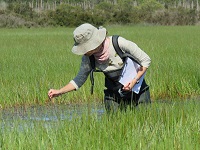The expansion of road networks and the increase in traffic have emerged in recent years as key threats to the conservation of biodiversity. This is particularly concerning in many protected areas because the increase of recreational activities requiring the use of vehicles. Effects of roads and traffic within guild scenarios and ecological processes remain however poorly known. This study examined how road proximity and traffic intensity influence patterns of resource use in an Old-World avian scavenger guild living in a protected natural park in northern Spain. 130 carcasses were experimentally placed at different distances from a scenic road in the centre of the park. Vehicles were recorded by means of traffic counters which revealed that maximum numbers were reached during weekends and holidays and during the middle hours of the day. Avian scavenger attendance at carcasses was recorded by means of camera-traps. Obligated scavengers, Eurasian griffon and Egyptian vultures were frequently observed (59.4% and 37.7% of the consumed carcasses) together with five other facultative scavenger species. It was found that the richness (number of species) and the probability of consumption of the resource were reduced the smaller the distance to the road and in days with higher traffic intensity. The same factors affected the probability of presence of all the scavenger species. Moreover, some of them, notably griffon vultures, showed hourly patterns of carcass attendance suggesting avoidance of maximum traffic levels. These results highlight that roads and traffic would trigger consequences on the structure and functioning of scavenger food webs, which may be particularly concerning in protected areas with remarkable levels of biodiversity. Future regulations at protected areas should couple both traffic and tourist affluence with wildlife conservation. In this way important ecological processes would be preserved while maintaining a good dissemination of natural values. informacion[at]ebd.csic.es Donazar et al (2018) Tourism in protected areas: Disentangling road and traffic effects on intra-guild scavenging processes. Sci Total Environ https://doi.org/10.1016/j.scitotenv.2018.02.186



 La Fundación Jaime González-Gordon ofrece cuatro becas para el desarrollo de Trabajos de Fin de Máster sobre Doñana
La Fundación Jaime González-Gordon ofrece cuatro becas para el desarrollo de Trabajos de Fin de Máster sobre Doñana
